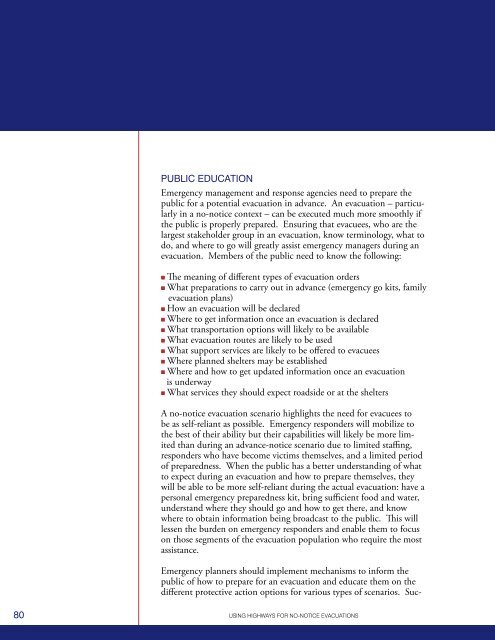using highways for no-notice evacuations - FHWA Operations - U.S. ...
using highways for no-notice evacuations - FHWA Operations - U.S. ...
using highways for no-notice evacuations - FHWA Operations - U.S. ...
Create successful ePaper yourself
Turn your PDF publications into a flip-book with our unique Google optimized e-Paper software.
PUBLIC EDUCATIONEmergency management and response agencies need to prepare thepublic <strong>for</strong> a potential evacuation in advance. An evacuation – particularlyin a <strong>no</strong>-<strong>no</strong>tice context – can be executed much more smoothly ifthe public is properly prepared. Ensuring that evacuees, who are thelargest stakeholder group in an evacuation, k<strong>no</strong>w termi<strong>no</strong>logy, what todo, and where to go will greatly assist emergency managers during anevacuation. Members of the public need to k<strong>no</strong>w the following:n The meaning of different types of evacuation ordersn What preparations to carry out in advance (emergency go kits, familyevacuation plans)n How an evacuation will be declaredn Where to get in<strong>for</strong>mation once an evacuation is declaredn What transportation options will likely to be availablen What evacuation routes are likely to be usedn What support services are likely to be offered to evacueesn Where planned shelters may be establishedn Where and how to get updated in<strong>for</strong>mation once an evacuationis underwayn What services they should expect roadside or at the sheltersA <strong>no</strong>-<strong>no</strong>tice evacuation scenario highlights the need <strong>for</strong> evacuees tobe as self-reliant as possible. Emergency responders will mobilize tothe best of their ability but their capabilities will likely be more limitedthan during an advance-<strong>no</strong>tice scenario due to limited staffing,responders who have become victims themselves, and a limited periodof preparedness. When the public has a better understanding of whatto expect during an evacuation and how to prepare themselves, theywill be able to be more self-reliant during the actual evacuation: have apersonal emergency preparedness kit, bring sufficient food and water,understand where they should go and how to get there, and k<strong>no</strong>wwhere to obtain in<strong>for</strong>mation being broadcast to the public. This willlessen the burden on emergency responders and enable them to focuson those segments of the evacuation population who require the mostassistance.Emergency planners should implement mechanisms to in<strong>for</strong>m thepublic of how to prepare <strong>for</strong> an evacuation and educate them on thedifferent protective action options <strong>for</strong> various types of scenarios. Suc-80 USING HIGHWAYS FOR NO-NOTICE EVACUATIONS
















